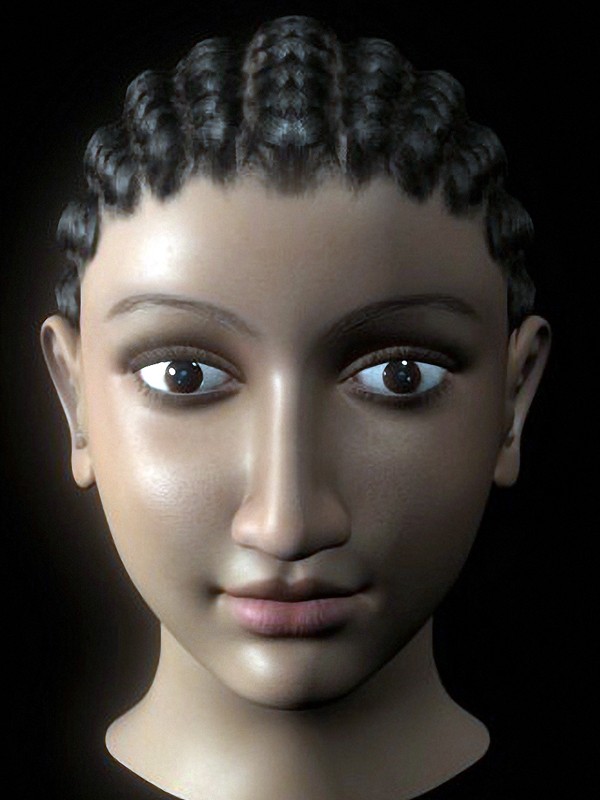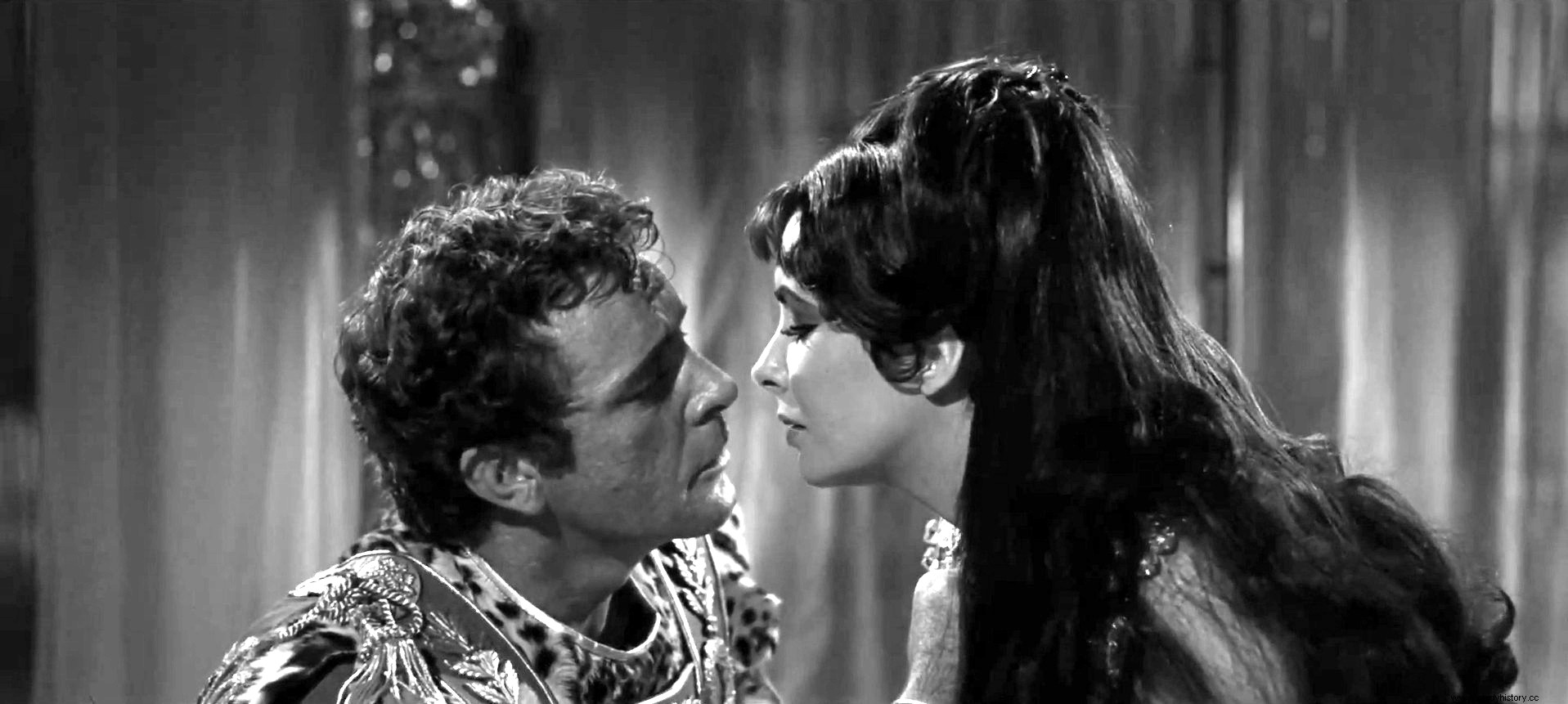We don't know how exactly she was Cleopatra , the last queen of Egypt, but we know that, if not exceptionally beautiful, her arts of seduction were many and complex. She was a lover of luxury, ostentation and jewelry, she was passionate about power and pleasures of the mouth; of gastronomy and oral sex, to the point that her contemporaries called her " the open-mouthed ” and “the mouth of the ten thousand men ”. Lover of the most powerful men of her time, first Julius Caesar and then Marco Antonio , by the first she had a son, Ptolemy XV or Caesarion , and of the second three, the twins Cleopatra Selene II and Alejandro Helios , and Ptolemy Philadelphus . Her arts of seduction were many and complex, because, although she was generally credited with exceptional beauty, various engravings and drawings seem to indicate that her charms lay more in her complex personality than in her physical appearance. . This is also clear from Plutarch's testimony in his work Parallel Lives , where it can be read:“ It is claimed that her beauty, considered in itself, was not so incomparable as to cause astonishment and admiration, but her treatment was such that it was impossible to resist. The charms of her figure, seconded by the courtesies of her conversation and by all the graces that come from a happy personality, left a sting in the mind that penetrated to the most alive. He possessed an infinite voluptuousness when speaking, and so much sweetness and harmony in the sound of his voice that his tongue was like a multi-stringed instrument that he handled easily and from which he extracted, as he saw fit, the most delicate nuances of language»(… ) «Plato recognizes four types of flattery, but she had a thousand ”.

Cleopatra facial reconstruction
Seductive through the stomach in the most traditional style
Cleopatra, like so many women throughout history, seemed to be convinced that gastronomy could be an effective weapon of seduction and that men are conquered by their stomachs, which in such a remarkable character could seem like a sign of simplicity. and elementality.
A blunder in the light of contemporary nutritional science since it is known that the consumption of foods rich in the amino acid phenylalanine, such as red meat, eggs, chickpeas or asparagus, activates the production of oxytocin, a hormone which acts as a brain neurotransmitter and has come to be called «the molecule of love » for its ability to induce physiological processes that lead to falling in love. Surely unaware of these circumstances but full of intuitions, Cleopatra managed her way and so it seems that her love story with Marco Antonio was consolidated after a gastronomic bet.
Luxury menus, sweetness and voluptuousness
In the sixties of the last century, in the texts of the religion books, a logically obligatory subject in all the Francoist national-Catholic education courses, it was frequent that, we do not know on what basis, the relations between Marco Antonio and Cleopatra noting that:«they lived in mournful partnership » and «given to vice, softness and voluptuousness «. Of all this, perhaps the closest thing to the pleasures of the table may be the sweetness, understood as "excessive comfort or gift", and perhaps the influence of the Greek and Roman banquets that led the Egyptians had a lot to do with it. powerful people of the time to put on their tables dishes such as the tongues of different birds, wild boar stuffed with black pudding, dormouse with chestnuts or goose livers dipped in milk and honey. On the other hand, it is said that the couple led to the creation of one of the oldest gastronomic associations in history, the Circle of the Inimitables , a group of sybarites who organized hunts, extremely high-end banquets and occasional incursions into popular neighborhoods to discover the arcana of commoner cuisine. However, the cuisine of Cleopatra's time moved in other standards that were much simpler and less impressive.

Cleopatra (Elizabeth Taylor) and Mark Antony (Richard Burton)
Haman Mashi for the loving couple
The discovery of some papyri found in the oasis of Fayum , the richest during the reign of Cleopatra, reveal valuable information about the gastronomy of those years and allow us to venture a possible daily menu at the pharaoh's table, which she probably shared on some occasion with her triumvir in love. Probably the reference dish would be the Haman Mashi , pigeon stuffed with rice or green wheat, accompanied by vegetables of the time, which has survived almost intact to this day in Egyptian cuisine. Later would come a bean and barley soup, roasted game meat, fish from the Nile prepared on spit, and fig and nine cakes covered in honey. All this washed down with Greek wine and the very Egyptian beer.
In any case, Cleopatra's menus certainly didn't lack lettuce , which at that time was of a species very similar to the current Roman one, although with more elongated leaves. The vegetable was considered a sacred food and associated with Min, god of fertility and various other things, who was represented as a black or green man, but always endowed with a prominent and erect phallus. The ancient Egyptians considered lettuce to be a first-rate aphrodisiac, which made men fall in love and made women fertile. From this perception and with the intense bustle of coyunda that the couple brought, it is easy to imagine that it always appeared on their menus, raw, seasoned with olive oil and salt, and accompanied by long green onions that appear in as many hieroglyphs as matter as an offering to the gods.

Cleopatra, the open-mouthed (Illustration by the painter José Antonio Alcácer)
Under the stomach flattery and flashes of bukkake
Returning to the thousand Cleopatriline compliments of which Plutarch spoke, among those, in addition to the gastronomic ones, the queen's ability to practice oral sex must have been placed in positions of privilege, an art that was practiced with singular mastery by professional and amateur felatrices who they painted their lips in such a way that the would-be fellatio would know in advance what that mouth offered or at least promised. Between history and legend, a story has reached our days, with certain overtones of credibility, of a summons by the Egyptian sovereign attended by a hundred Roman officers, who, after being splendidly attended orally by the hostess, ejaculated in a great golden cup that was finally drunk by the sovereign. If the story is true, and as has been said it is more than likely that it is, Cleopatra, and not the Japanese directors, would have been the true inventor of bukkake , a pornographic genre of group sex in which several men ejaculate on the body, face or mouth of a person, man or woman, and this person ends up drinking the seminal fluids previously deposited in a glass or cup. The bukkake , voice that derives from the noun form of the Japanese verb bukkakeru , which means watering, throwing water, pouring it or splashing it, emerged as a porn film genre in the 1990s largely as a result of the limitations of the censorship of the Japanese authorities that prevented the showing of images of pubic hair and penetrations, both vaginal and anal.
Her legend of her ardor also makes her the inventor of the vibrator , not the dildo. In 2005 German scientists discovered in the cave Hohle Fels (Germany) what can be considered the oldest dildo in history; it is a perfectly polished stone phallus about twenty centimeters long -the standard measure in my town- that would be about 28,000 years old. And Cleopatra would have been the one who made the leap from dildo to vibrator. In the absence of batteries or electricity, her dildo vibrated in a “natural” way:living bees would get into a dry, hollow gourd and flutter around, causing the vibration (Don't try this at home! And if you do, choose a proper gourd and make sure the bees can't get out).
Be that as it may, between banquets, refined entertainment, and fellatio with toegonic roots in the myth of Isis and Osiris, this is how the days passed for what, according to the American critic and literary theorist Harold Bloom, was the first celebrity of the world.
Collaboration of Miguel Ángel Almodóvar for iHstoria Magazine
